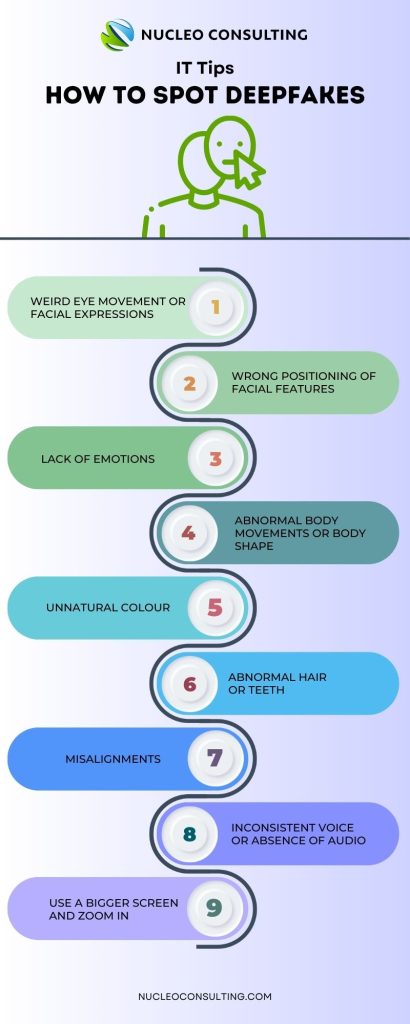Deepfake refers to the use of Artificial Intelligence (AI) and machine learning techniques to create or manipulate videos, images, or audio recordings that seemed to be authentic. In fact, these synthetic or altered contents are often very well created, most individuals would not know that it’s actually fake.
Deepfake technology emerged as a powerful AI tool. It uses powerful algorithms, such as generative adversarial networks (GANs), to analyze and learn from large amounts of data, such as videos or images. By training these data sets, the AI system can generate highly realistic imitations contents. Deepfake technology has gained attention in the world of technology, mainly for its ability to create convincing videos. Some popular use of deepfake technology is to replace a person’s face in a video, also referred to as face-swapping.
Danger of Deepfake
Deepfake technology has been widely used in recent years. The contents can be found on social media platforms such as Facebook, Instagram, or Tiktok. While deepfake technology can be used for harmless entertainment purposes, it also poses risks as it blurs the line between truth and fiction. Here are some examples of how deepfake is misused:
- Phishing and other scams
- Tarnish reputations
- Impersonation
- Social engineering
- Disinformation
- Corporate and financial fraud
- Identity theft
- Blackmailing
Truth is, the deepfake technology isn’t new. For instance, in 2022, a report shared that a man’s face was deep-faked into a pornography video after picking up a call from a UK-registered number. The cybercriminals proceeded to use the video for blackmailing purposes and tarnished his reputation after failing to receive any money from the victim.
In the world of evolving technology, tactics used by scammers will continue to advance. It is essential to be informed of these scams and educate our loved ones on preventive measures against such scams.
Identification & Prevention
Detecting deepfakes can be a challenging task, but not impossible. Here are some tips on how you can spot them:

- Weird eye movements or facial expressions
Look closely at the content and try spotting any weird facial expressions or eye movements. If it does not look natural, or if the eyes lack natural movements such as blinking, it may be a deepfake!
2. Wrong positioning of facial features
If the content features someone’s face looking in 1 direction, and the nose pointing another direction, you should be skeptical about this content.
3. Lack of emotions
Does the emotion or expression match what the person is saying? If the content is lacking emotion or doesn’t go along with what the person is saying, you may have spotted image stitching, also known as facial morphing.
4. Abnormal body movements or body shape
Look out for inconsistency in the positioning of the head or body. If they do not look consistent while moving, seemed jerky while moving, or are distorted from one frame to the next, the video may be fake.
5. Unnatural color
Pay attention to the lighting and skin tones. Are there any abnormal skin tone, discoloration, misplaced/ lack of shadows, or weird lighting? If you spot any of these, you should be skeptical about the authenticity of this content.
6. Abnormal hair or teeth
Does the hair or teeth of the person in the video seem abnormal? This is because AI-generated content may not be able to generate individual teeth. Fake contents often lack individual characteristics such as frizziness or any flyaway hair, or the absence of outline of individual teeth.
7. Misalignments
Take a good look at the edges of the content, especially at the neckline where the face and body meet. If something looks misaligned, or blurry, the content is probably not authentic!
8. Inconsistent voice or absence of audio
Listen carefully to the sounds and audio of the content. Look out for red flags such as poor lip-syncing, abnormal pronunciation, weird accents, digital background noise, robotic-sounding voices, or even the absence of audio.
9. Use a bigger screen or zoom in
It is easier to spot the red flags when you watch the videos on a larger screen or slow down the playback of the video. Zoom in to places like the lips, teeth, hair, or neckline to spot any abnormalities as mentioned above.
While deepfake technology seemed to be fun and entertaining, it could also be misused and poses serious risks to individuals and businesses. From scams and blackmailing to disinformation and reputational damage, the impact of deepfakes can be destructive. By remaining well-informed, spreading awareness, and being vigilant for the indicators of fake content, we can fully embrace the potential of this technology without worry.
IT Tips | Cybersecurity | Cyber Threats | Deepfake | Technology | Scam